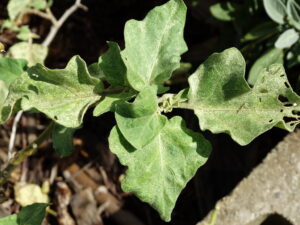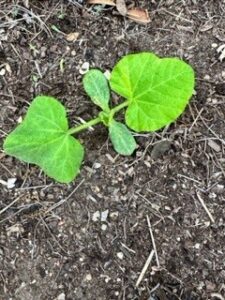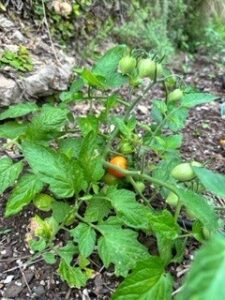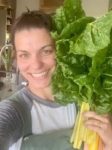Austin’s May Vegetable Garden Checklist Tips from Paula Wolfel

Stippling on the surface of leaves is an indication that spider mites are present. Take action to save the plant.
May is upon us and are veggies are growing! I am already picking tomatoes, radishes, asparagus, snap peas, and lots of lettuces and greens. You still have time to get new plants in before the summer heat arrives. Make sure you are staying on top of your watering as it is the most important task for May. Your vegetable garden prefers rain but if those drops are not falling from the sky, then make sure you are watering plants deeply to train roots away from the dry soil surface. Hot days and warm nights are also favorable for pests of all kinds. Check regularly for insects on stems and the underside of the leaves. Look for eggs and infant stages of pests (hint: they are usually in large groups) and treat as needed to avoid serious damage to your vegetables. Spraying a pesticide is not always the answer. Some larger pests, such as hornworms and stinkbugs, can be picked off by hand, and smaller pests, such as spider mites and aphids, are easily dislodged with a strong spray of water. The key is to stay ahead.
The May Vegetable Garden Checklist
Here is what you can do in the garden this month:
FERTILIZE
- May is our rainiest month and will wash out liquid fertilizers. Switch to granules unless the weather is dry.
- Fertilize fruiting vegetables (tomatoes, squash, cucumbers, peppers, eggplant) with when the first fruit appear, and again 3-4 weeks later.
- Fertilize non fruiting vegetables every two weeks.
WATER
- Be mindful of prolonged hot temperatures and plants needing more consistent watering. Depending on your soil type, this could be daily.
- When you do irrigate, water deeply. Dig down into the soil 6” to see if the soil is moist. If not, adjust your irrigation schedule to water longer or more frequently (or both if using the Cycle and Soak method.)
PLANTING
- Lettuce is out and summer greens are in. A few options include Malabar spinach, sweet potato leaves, golden purslane, molokhia, and vegetable amaranth. Don’t let amaranth spread – it is super easy to grow but can easily become a weed. If you plant summer greens and then decide that you are not a fan, don’t let them go to waste. Add them to your compost.
- Seeds or Transplants:
- Sweet potatoes (right away!)
- Beans, snap, lima, and yard-long (early month)
- Cantaloupe (all month)
- Greens- warm season (all month)
- Okra (all month)
- Peas, Southern such as black-eye, purple hull or crowder peas (all month)
- Potatoes, sweet- slips (all month)
- Pumpkin (mid-month)

It’s not too late to plant squash.
- Squash, winter (all month)
- Watermelon (all month)
- Transplant only
- Peppers (early-mid month)
SOIL
- If you are just starting your garden, add new, fresh soil where it is needed as gravity settles your planting beds. Add a thin layer of compost over the new soil and mix it in with the soil about an inch down.
- Mulching should be on your May vegetable garden checklist. Use mulch to protect the soil from drying out from the sun and to limit weeds.
DISEASES/PESTS TO LOOK FOR
- Your May vegetable garden checklist should have several items related to pests.
- Yellow specks or stippling on the surface of leaves is an indication that spider mites are present on the underside sucking chlorophyll right out of the leaf. An infestation will cause severe damage to plants, so it’s important to take action immediately. Blast them off with a strong spray of water directed at the underside of the leaves, or spray with insecticidal soap. You won’t get them all the first time, and eggs hatch every 3-5 days, so you’ll need to do this every 4-5 days.
- Aphids and white flies will be in abundance too. Blast them off with water aimed at the underside of leaves.
- Caterpillars of all kinds will continue to be a problem. Pick them off by hand or use an organic pesticide that contains Bt (Bacillus thuringiensis.)
MAINTENANCE
- As tomatoes grow, guide stems so they stay inside their cages. Once they escape it’s very difficult to pull them back inside the cage without snapping the stems.

- This is the perfect time to fill a compost bin with leaves, weeds, oak tassels, grass clippings and kitchen scraps. Keep the pile moist and turn occasionally.
HARVEST
- Onion bulbs expand as the days get longer, and when the tops fall over they are ready to harvest, usually by late May or early June. Harvest any onions that send up a flower stalk now. They are perfectly edible and will not get any bigger. They also don’t store well once the flower stalk appears, so enjoy them right away.
- Late in the month is a good time to dig around the base of your potato plants and harvest a few small new potatoes. Once the leaves turn yellow and start to die back you can pull up the entire plant and harvest all the potatoes.
- If Swiss chard starts to look ragged, cut it back a few inches above the ground and it will resprout.
Additional Resources
Watch the Vegetable Gardening in Central Texas Webinar
Recommended Vegetable Varieties for Travis County
Plant Rotations, Successions and Intercropping
Sustainable Food Center Farmers Markets
Monthly Gardening Calendar for Austin and Central Texas
About Paula Wolfel
 Paula Wolfel joined the Travis County Master Gardener program in 2022, but has been gardening in Austin, Texas since 2017. She grew up in the suburbs of Chicago learning how to garden from both her father—a Sicilian vegetable and fruit tree gardener—and both her grandmothers, and then spent years in Virginia gardening. Paula loves gardening because she finds it to be a grounding force- it gets her out of her head and into the present. She loves the pride that comes with cooking a meal for her family with every ingredient coming from her garden… and then the humility she feels when she loses an entire crop because of Mother Nature. She finds gardening to be wisdom, lessons, best practices passed down generation to generation, season to season and hopes to share that with you.
Paula Wolfel joined the Travis County Master Gardener program in 2022, but has been gardening in Austin, Texas since 2017. She grew up in the suburbs of Chicago learning how to garden from both her father—a Sicilian vegetable and fruit tree gardener—and both her grandmothers, and then spent years in Virginia gardening. Paula loves gardening because she finds it to be a grounding force- it gets her out of her head and into the present. She loves the pride that comes with cooking a meal for her family with every ingredient coming from her garden… and then the humility she feels when she loses an entire crop because of Mother Nature. She finds gardening to be wisdom, lessons, best practices passed down generation to generation, season to season and hopes to share that with you.

